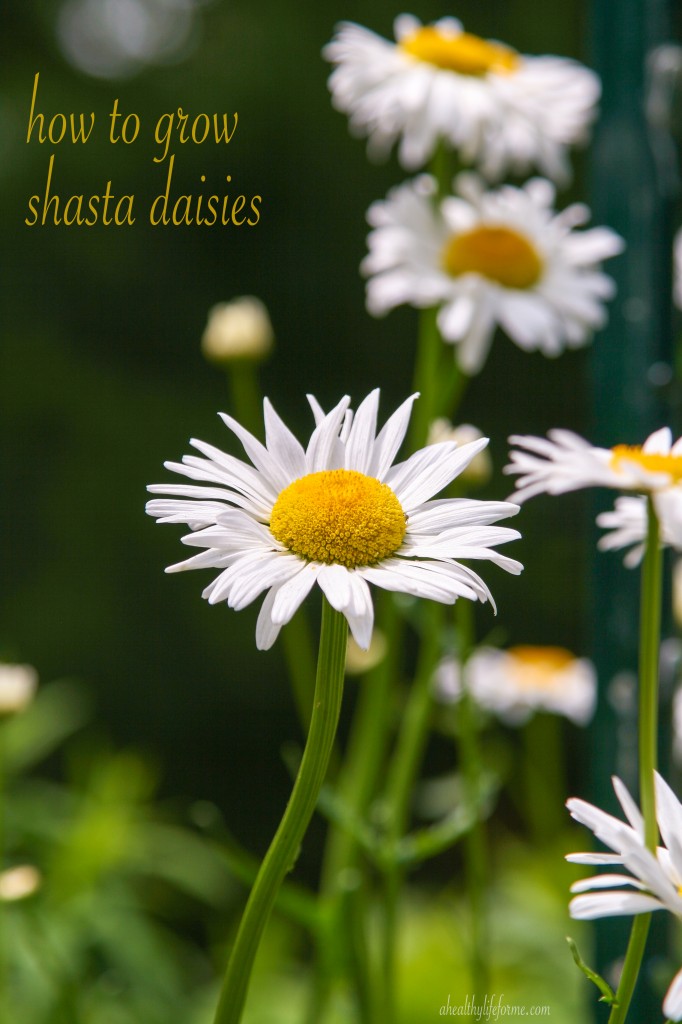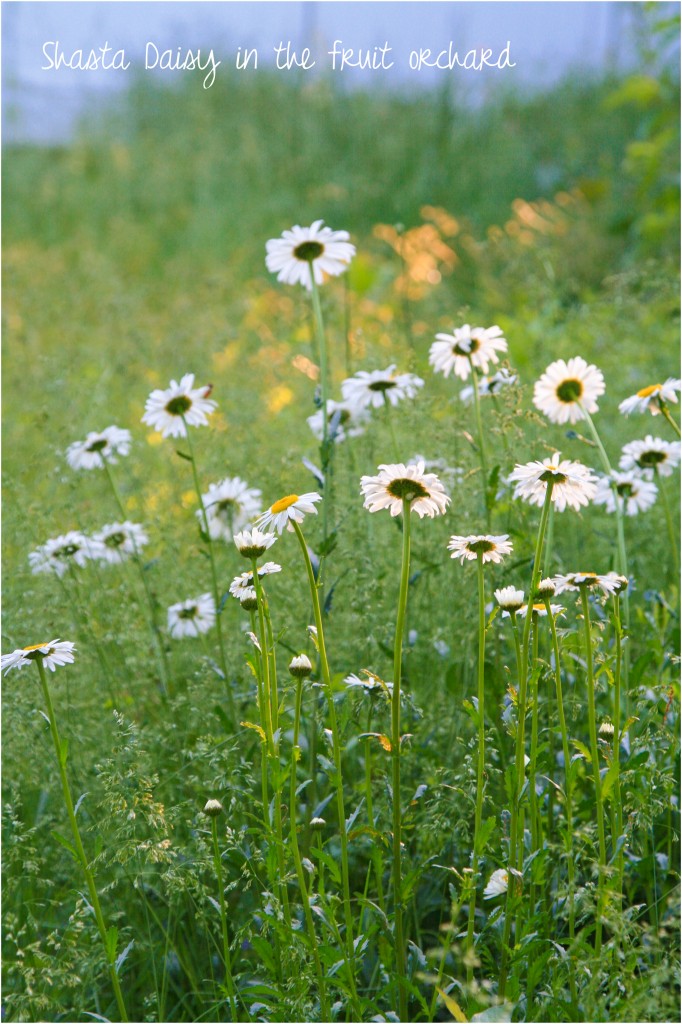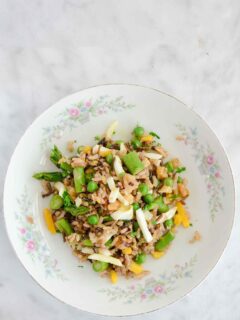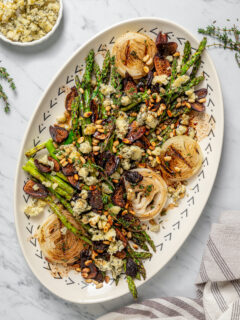Learn How To Grow Shasta Daisy and why you want this friendly flower in your garden. The Shasta Daisy is named after Mount Shasta in northern California, where the hybrid was developed by Luther Burbank. The word “daisy” originally meant “day’s eye” and was used to refer to the sun-like appearance of the flower.

Our first summer I put in a long Naturalizing bed where I could transplant existing plants, divisions and any new plants that tickled my fancy. One of the first additions to the bed were the struggling Shasta from the back bed that was in the shade. I was so excited for them to have a better home where they could thrive and prosper.
Oh did they ever prosper, the first few years they took over the bed, and I pulled half out and tried to find new places to plant them and I gave away clump after clump. Now in the year 2012, I have no friends that want anymore and no more room. So sadly starting early every spring, I compost Shasta’s (before they get flower heads). I leave just enough of them to dazzle away the spring, but not enough to overtake the later blooming perennials.
I always cut back the spent blooms towards the end of June to keep the bed looking neat and tidy, but I must not be quick enough because the little buggers drop their seeds everywhere.
Shasta’s make great cut flowers because of their large-flowered heads and long strong stems.
Shasta Daisies like the sun, but can tolerate morning or late day shade though you may not get as many blooms. Their heads rotate and open towards where the sun is shining (as you can see from the photo directly below). The grow anywhere from 6 to 36″ tall and their clumps are usually 18″ wide. Bees and Butterflies will visit the blooms and are a great source of pollen and nectar in the spring.
There are several different types, so make sure you read the tag description at the nursery so you pick the variety that will suit you and your garden best. I have single bloomers, but the doubles are very impressive, sturdy and blooming two rows of petals on each flower. I would caution away from any variety that needs staking. The last thing you want to do in spring, your busiest season in the garden is to be running around staking your Shasta’s so you can enjoy them.
Spring is the time to plant Shasta’s. Most garden centers carry container-grown varieties. Plant your Shasta Daisy by spacing plants 2 feet apart, depending on the variety. Prepare the garden bed by using a garden fork or shovel to loosen the soil to a depth of 12 to 15 inches, then mix in a 2 to 4-inch layer of compost. Dig a hole twice the diameter of the pot the plant is in. Carefully tap the outside of your plant container and remove the plant place it in the hole so the top of the root ball is level with the soil surface. Gently fill in the loose soil around the root ball and firm the soil gently and water thoroughly. You will need to divide every few years. Deadheading is a must unless you want them to spread and send up new plants.
Companion plants that grow well with the Shasta are vast, but a few great and easy spring bloomers you might like to try are Lambs Ear, Coreopsis, Baptisia, Columbine, Allium, and Iris.
Fun Fact:
Joe Fox gives Kathleen Kelly daisies when she is sick with a cold.
“I love daisies. Don’t you think they are they’re the friendliest flower”
The movie You’ve Got Mail– one of my all time favorites!















I had beautiful daisies every year.two feet high and getting wider each year. Last year it was like someone removed 3/4 of them and grew only 6 to 12″ high. This year I have so much grass growing between the daisies I don’t know what to do.
I am dividing my daisies and giving the new ones to my mom, but she lives in a place that has much harsher winters than me and her spring comes much later. How long can I leave the new divides out (or in non-permanent pots) before she MUST get them in the ground? Over here, I have new spring foliage on mine, but her ground is still frozen. It’s at tricky situation.
Hi Lanea, There are a lot of factors that will determine their success in transplanting, temperature, moisture, sunshine, how long the are in pots. However, I think that if you pot them up and give them water, sunshine and enough air circulation {don’t want them too wet or dry} they will transplant like champs. Just have her transplant when their is no chance of frost, and the grown is nice and warm.
this was very helpful! However do you think I would be able to plant Shasta daisies in August in Northern California? Specifically El Dorado Hills? We just moved and I really don’t know if I can wait until spring to plant them! Of course, I don’t want them to die by being planted too late in the season. Thank you for any help!
Hi Lora,
Sorry for the delay in replying. I wanted to ask some of my gardening friends on the west coast to answer your question. My friend Pamela from Flower Patch Farmhouse says “yes” she is always moving her shasta’s around and if you keep them watered until established they should do just fine. If you are interested in checking out Pamelas site: http://www.flowerpatchfarmhouse.com/. Best, Amy
Please tell me how to get my daisies to bloom. I have them in the yard in good soil and they are two feet apart and they get partial to shade sunlight. The soil stays moist and the plant seems to thrive but will not bloom. I have had them in the same spot for two years. The plants are not big or spreading. I know it because they don’t bloom. They were blooming when I bought them but have not done so since. Please help me.
Hi Betty,
Daisies usually don’t show blooms because they are not getting enough hours of direct sunlight, at least 5-6 hours. I would move them to a more sunny sight to ensure blooms.
Amy
Do you fence your flower beds to keep your chickens out? I’m having a hard time with my free roaming chickens. They want to be where I am and scratch up the newly planted seeds or peck off the tender green when it first appears. I’m on a tight budget and afraid whatever fencing I can come up with will be ugly. Any suggestions would be appreciated!
Hi Cheryl,
I do have a fence around my garden, during the spring when I am planting and the seedlings are getting their rooting established, I keep the chickens out. I let them in later in the season, when I need their bug control. How big of an area are you fencing in? I saw this fencing for a small area over on two twenty one and I thought it was cute, inexpensive and easy to put in and remove later. http://www.twotwentyone.net/2013/05/diy-garden-fencing/ It would also keep out rabbits which are a problem for me. Hope this helps.
Amy
Thanks for visiting!
I adore Shasta Daisies! They are the happiest flower! Or, should I put it this way: daisies are the happiest flower, since there are so many varieties! But Shastas have always been a favorite of mine! Great article/post! Thanks for the ping back!